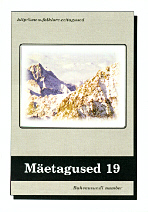Tähistaeval põhinevatest uskumustest III. Vana-Hiina
On Beliefs Related to the Starry Sky III. Ancient China
Author(s): Enn KasakSubject(s): Customs / Folklore
Published by: Eesti Kirjandusmuuseum
Summary/Abstract: The article concerns Chinese astral myths, calendar and astrology. Chinese creation myths concern also the creation of the Sun, Moon and stars. The heavenly bodies are constantly endangered by the sky dragon that now and then catches them, probably a reference to eclipses. Cosmology existed in Ancient China in the same sense as in Ancient Greede, though many ancient books were burned on the emperor's orders in 213 BC. Teaching of the endless sky emerged in the Han era, while in 1 century AD the theory of endless empty space was formulated. For the majority of Chinese history, astronomers were in the service of the country - studying and interpreting heavenly phenomena. The Chinese divided the heavenly sphere into several hundred little constellations of one to ten stars. They used the so-called Lunar Zodiac that contained 28 xiu or homes of the Moon but also the Sun Zodiac. Myths concerned the stars and their naming. Heavenly processes were believed to influence the earthly. From China come the earliest observations of solar eclipses and comets. The earliest registered solar eclipse is dated in 720 BC. There are also records about ceremonies dedicated to solar eclipses. Halley's comet has been sighted and recorded since 12 BC at its every passage, but irregularly already since 240 BC. The very first comet descriptions come from 1057-1056 BC. Chinese chronology is based on imperial eras: the inauguration of every emperor started a new era. The Chinese lunar-solar calendar was improved via constant observations. Seasons were determined by the position of the Ursa Major at dawn. The length of synodic months at the time was 29.5 days and a topic year 366 days. A supplementary month was added according to a 19-year cycle. Chinese calendar achieved its contemporary form in 7th-10th centuries.
Journal: Mäetagused. Hüperajakiri
- Issue Year: 2002
- Issue No: 19
- Page Range: 25-55
- Page Count: 31
- Language: Estonian

